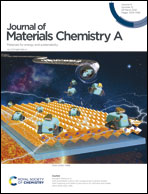Metal-ionic-conductor potassium ferrite nanocrystals with intrinsic superhydrophilic surfaces for electrocatalytic water splitting at ultrahigh current densities†
Abstract
Developing new electrocatalysts with high activity and good stability for hydrogen evolution reactions (HER) and oxygen evolution reactions (OER), in particular superhydrophilic ones that can significantly enhance mass transfer between electrodes and electrolytes at high current densities, remains a challenge. Herein, we report that K2Fe4O7 nanocrystals (nano-KFO) are hydrothermally grown on a nickel foam (NF). The formed nano-KFO/NF exhibits good stability and delivers an extremely large current density up to 2000 mA cm−2 at low overpotentials of 343 mV (HER) and 421 mV (OER) in 1.0 M KOH electrolyte. By employing nano-KFO/NF as both cathode and anode, a water electrolyzer can operate over 60 hours at a current density of 1500 mA cm−2 with cell voltages of 2.01 V in 1.0 M KOH and 1.89 V in 10.0 M KOH, demonstrating the great potential of this bifunctional electrocatalyst for large-scale hydrogen production. Our theoretical calculation reveals that the structure has instinct high catalytic activities for both HER and OER in alkaline media. In addition, the large surface area, good conductivity, and inherent superhydrophilic properties of nano-KFO lead to its highly efficient electrocatalytic water splitting performance.



 Please wait while we load your content...
Please wait while we load your content...